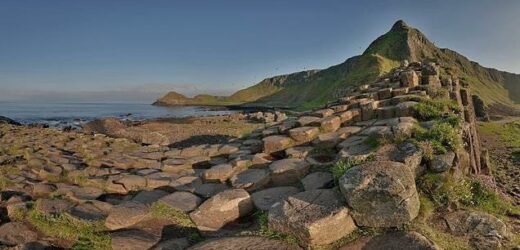Unravelling the mystery of Giant’s Causeway: Striking stones in Northern Ireland were formed in a matter of DAYS – and not over thousands of years as previously thought, study claims
- Giant’s Causeway is an unusual formation of around 40,000 hexagonal stone columns in Northern Ireland
- Researchers have now put forward the first new theory on their formation since 1940
- They claim the stones were formed in an event that took days, and not thousands of years
- This could help to explain why the extraordinary geological features are found at sea level only
Every year, millions of tourists flock to Northern Ireland to visit Giant’s Causeway – an unusual formation of around 40,000 hexagonal stone columns descending gently into the sea.
Theories on the stones’ formation range from them being built by a mythical giant Finn McCool to more scientific explanations.
Now, Dr Mike Simms, curator of natural sciences at National Museums NI, has put forward the first new theory since 1940.
Dr Simms considered why the extraordinary geological features are found at sea level only.
To mark Unesco’s International Geodiversity Day today, he has explained why he believes they were caused by an event which took just days – and not thousands of years as previously thought.
Every year, millions of tourists flock to Northern Ireland to visit Giant’s Causeway – an unusual formation of 40,000 stone columns descending gently into the sea
The scientific explanation for its formation, widely accepted for decades, is that a river valley was filled with lava that ponded to a greater depth than normal. Pictured: Geological map of the area under investigation
What is Giant’s Causeway?
Giant’s Causeway takes up about four miles of the coast of Northern Ireland.
About 40,000 stone pillars make up the tourist attraction, and these pillars typically include five to seven sides.
According to Britannica, the site was formed 50 to 60 million years ago.
It was formed during the Paleogene Period and was the result of lava creeping toward the coast but cooling after making contact with the sea.
Giant’s Causeway was first recorded in 1693, and it has been a point of intrigue for geologists.
It is managed by the National Trust, which is a British organization in charge of preserving natural wonders.
In 1986 it became a UNESCO World Heritage site, and the protected area is home to about 50 species of birds and upwards of 200 plant species.
Giant’s Causeway takes up about four miles of the coast of Northern Ireland.
About 40,000 stone pillars make up the tourist attraction, and these pillars typically include five to seven sides.
The site was formed 50 to 60 million years ago during the Paleogene Period, and became a UNESCO World Heritage site in 1986.
The scientific explanation for its formation, widely accepted for decades, is that a river valley was filled with lava that ponded to a greater depth than normal.
As the thick layer of lava cooled and solidified it formed these regular columns.
However, Dr Simms has put forward the idea that if this lava-filled hollow was a valley it would have cut through old layers of lava beneath.
He has identified layers of old lava on the shore either side of the Giant’s Causeway sloping inward where older layers have not eroded away.
Dr Simms said: ‘An analogy I find helpful when explaining this involves cake.
‘Eroding a river valley is rather like cutting through a layer of cake to reveal layers beneath the surface.
‘In my interpretation, what we actually see are layers of older rock sloping towards the Causeway – more like a badly baked cake that has sunk in the middle.
‘I believe the ground subsided as lava moved up and erupted at the surface.
‘The lava filled the depression creating the conditions for the columns to form.
‘This event likely took just a few days rather than the many thousands of years that would be needed for erosion to create a river valley.’
Dr Simms explained he first started thinking about the theory while leading a field trip to the World Heritage Site in 2012.
‘I owe a particular debt of gratitude to another geologist, a young Brazilian man who was on a field trip I was leading in 2012,’ he said.
‘He questioned how long it would take to erode the supposed river valley, and it was this that opened my eyes to the evidence before me.
‘I had visited the Giant’s Causeway many times before, and until that moment I had just accepted the previous theory.
Dr Simms explained he first started thinking about the theory while leading a field trip to the World Heritage Site in 2012
The Giant’s Causeway is Northern Ireland’s only Unesco World Heritage Site and is operated by the National Trust, which has acknowledged Dr Simms’s theory
‘It goes to show that even at world famous landmarks such as this, new discoveries can be made from a simple observation.’
The Giant’s Causeway is Northern Ireland’s only Unesco World Heritage Site and is operated by the National Trust, which has acknowledged Dr Simms’s theory.
Max Bryant, general manager at Giant’s Causeway and Carrick-a-Rede, said there can always be new possibilities and perspectives waiting to be discovered.
‘It highlights just how marvellous, magnificent and mysterious a geological formation we have here in Northern Ireland to share with the world,’ he said.
Kathryn Thomson, chief executive of National Museums NI, said she is proud to support Dr Simms’s findings.
‘I think it’s wonderful he has showcased the expertise of our team and how important museums are,’ she said.
‘Yes, we provide spaces for people to explore and learn, but our teams also make meaningful contributions elsewhere.
‘As a knowledge-based organisation, our staff are uniquely placed to present research and ideas.
‘By using our vast natural science collections, for instance, we can support new discoveries and promote responsible and ethical action when it comes to our natural world.’
Source: Read Full Article






